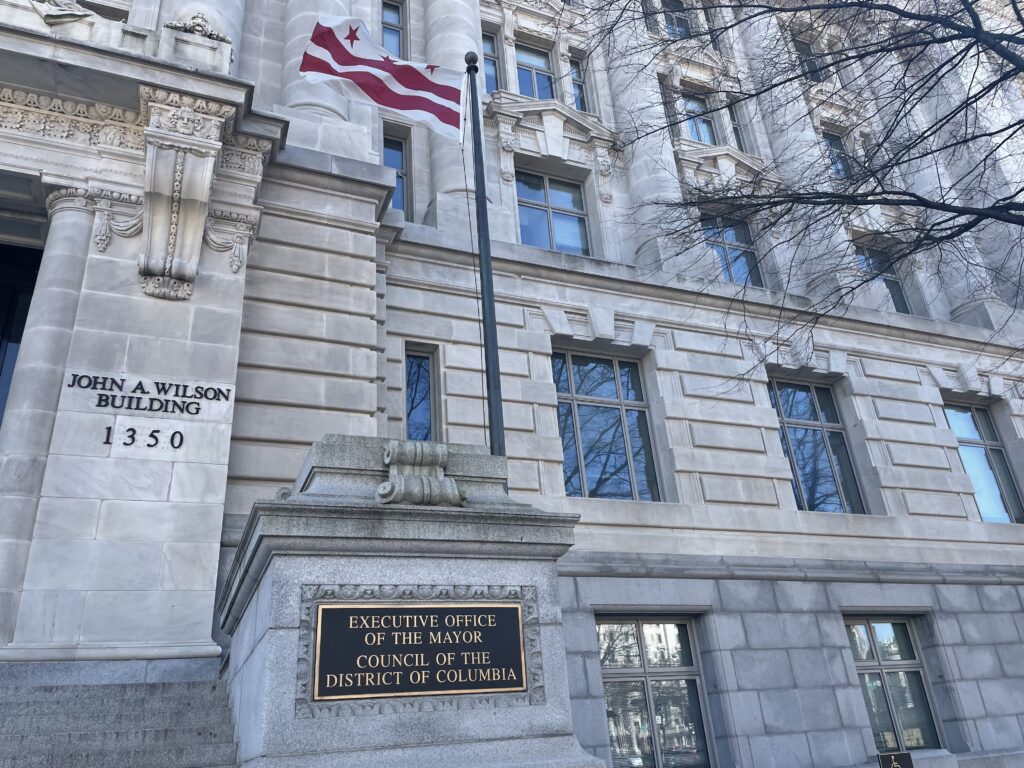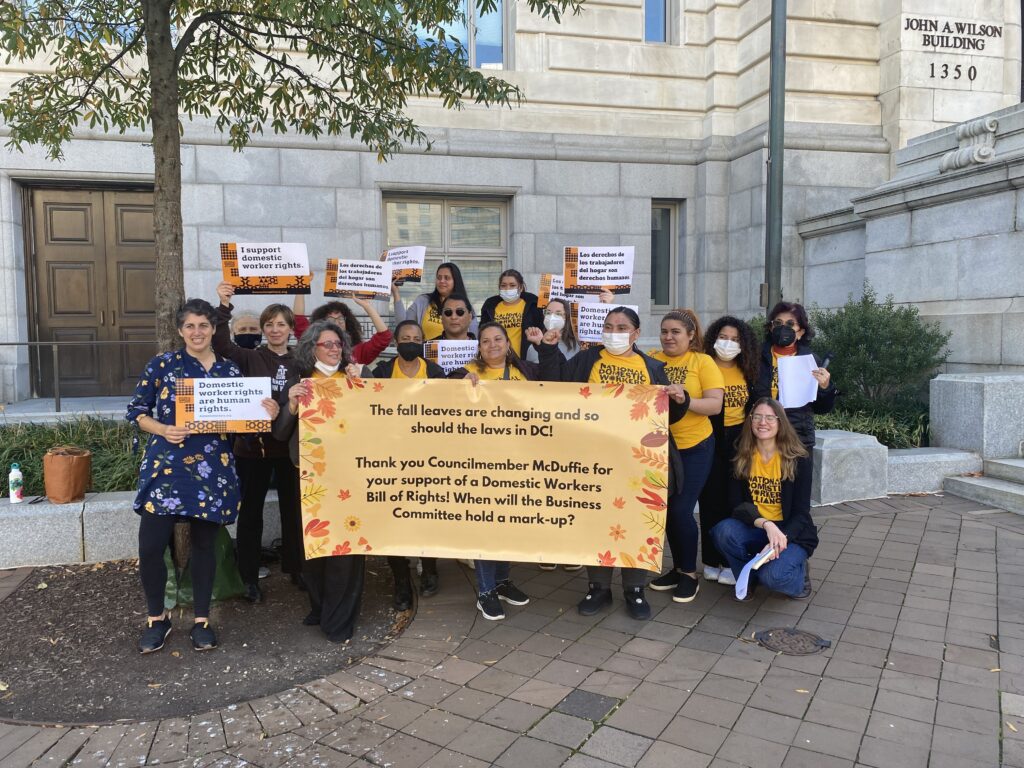The nine-hour budget oversight hearing for D.C.’s Department of Human Services (DHS) was full of warnings.
Dozens of witnesses testified that adopting Mayor Muriel Bowser’s proposed budget, which cuts pandemic-level funding for an array of housing and social safety net programs, would lead to increased poverty and homelessness in D.C.
From fiscal year 2020 to 2023, the District increased funding for a range of programs meant to provide economic and housing stability for residents. With the end of the public health emergency, federal funding is disappearing at the same time the District is seeing years of revenue growth stall. To avoid a budget gap, Bowser has proposed reducing spending on these programs to pre-pandemic levels — a step she and her administration say is essential to limit costs to what the city can afford.
But people who rely on these programs — as well as representatives of the nonprofits that help administer many of them — argue the pre-2020 funding levels were never sufficient, and say that many households are still feeling the effects of the pandemic and rising prices. At the Housing Committee’s March 31 oversight hearing on the proposed DHS budget, residents called for increases in funding for eviction and homelessness prevention, cash and food assistance, and domestic violence and youth workforce programs — demands largely echoed by the Fair Budget Coalition.
“The mayor’s budget is emblematic of a crisis,” Niciah Mujahid, the executive director of the Fair Budget Coalition, said at the hearing. “It is absolutely immoral, to the point of pure shamelessness, for the FY 24 budget to make proposed cuts to indispensable human services.”
Over the past few weeks, councilmembers have indicated some willingness to increase funding for social services, especially rental assistance, but they would need to cut other programs to do so. Council committees will begin marking up the budget on April 25, with a first vote of the full council on May 16.
“It’s ridiculous how it always seems that the poor have to get shafted every time the budget needs to be made,” testified Francwa Sims, who previously experienced homelessness and now uses a housing voucher.
Eviction and homelessness prevention resources hit big
Lark Catoe found out just one day before the budget hearing that her eviction case had been resolved — because the Emergency Rental Assistance Program (ERAP) was able to cover the back rent she owed. ERAP isn’t just important to her personally, she testified, but can be an important tool to make sure people who are being priced out of the city aren’t displaced.
“You can’t just fund ERAP — you have to make sure people can stay in this city. It has to be a larger amount, [and] you can’t have all these conditions,” Catoe said. “Help the many that are out here.”
ERAP, which saw large funding increases during the pandemic, provides a limited amount of rental assistance to tenants who have past-due rent or need help moving into a new home to avoid homelessness. For cases like Catoe’s, where overdue rent is the primary issue, the program can prevent evictions. Advocates see the program, which is already closed to applications in fiscal year 2023 due to limited funds, as a key way to prevent homelessness by keeping people in stable housing.
Catoe was among over 20 speakers at the hearing who decried Bowser’s proposed $35 million cut to ERAP in fiscal year 2024. Bowser contends that the outsized need for ERAP during the public health emergency has subsided. Councilmembers and advocates, however, estimate the need is in fact higher than this year’s budget of $43 million, somewhere between $85 million and $117 million. In questioning, DHS Director Laura Zeilinger predicted the proposed ERAP budget of $8.2 million for fiscal year 2024 would last two months.
“If we don't significantly increase ERAP funding, there will be a flood of evictions next year,” testified Lori Leibowitz, who worked on creating an eviction prevention framework for D.C.
While ERAP has received the most attention, Bowser also proposed cutting funding by more than half for another eviction prevention initiative, known as the Access to Justice Grants Program. In fiscal year 2023, the program spent over half of its $31 million budget on eviction prevention. It is the main source of funding for the Civil Legal Counsel Projects Program, which provides representation to renters in D.C.’s Landlord-Tenant Court.
Leibowitz, who worked with other legal services providers to launch the Landlord-Tenant Legal Assistance Network hotline in 2020, said the decrease would jeopardize the work D.C. has done over the last few years to prevent evictions. Having access to an attorney through the hotline increases the likelihood that a tenant will win their eviction case; in fiscal year 2022, the program helped four-fifths of its clients stay in their homes. The cut comes as eviction filings are rising, according to the D.C. Access to Justice Commission.
Bowser’s proposed budget also halves the $2.4 million allocation for Project Reconnect, a diversion program that helps people entering the District’s shelter system connect with other resources, such as family, friends or past employers, in an effort to prevent homelessness.
Combined decreases in federal and local safety net budget
D.C. residents who receive government benefits would see decreased aid under the proposed budget, which cuts cash benefits distributed through Temporary Assistance to Needy Families (TANF). The mayor also did not propose using local funds to offset federal money lost from the Supplemental Nutrition Assistance Program (SNAP).
The TANF cuts, which come mainly from an $11.2 million decrease in the program’s local funding for cash assistance, is a reversal of pandemic funding that was based on increased need at the time, according to the mayor’s budget. The program provides monthly cash assistance to low-income families, and it is one of the main forms of assistance targeting child poverty.
Several people who testified at the hearing said that D.C., rather than cutting TANF, should increase the monthly payments. Haley Hoff, a staff attorney at Legal Aid DC, said that small increases in recent years have not been enough for TANF benefits to keep pace with inflation for the 15,000 families in D.C. who receive them. And, even before the pandemic, D.C. had a child poverty rate of 23%, the seventh highest in the nation among states. Hoff and other advocates suggested that D.C. match the benefit available in New Hampshire, which would increase the maximum monthly amount for a family of three from $696 to $1,151.
District families are already experiencing a cut in monthly SNAP benefits, which help low-income households purchase groceries. While the federal government boosted benefits during the pandemic — with an average monthly increase per person of $90 — the emergency allotments ended in February. This returned D.C. families to receiving an average benefit of just over $6 a day, with a food security gap estimated to be at least $160 million.
The decrease is already having an impact, Martha Assefa from DC Hunger Solutions testified, with families being forced to choose poorer quality food and running out of money by the last week of the month.
While D.C. can’t control federal levels of SNAP support, the D.C. Council last year sought to offset some of the loss of the pandemic emergency allotment by passing the Give SNAP a Raise Amendment Act of 2022, which would have raised monthly household benefits by $47 on average. The bill’s $50 million cost is not funded in Bowser’s proposed budget.
“For every dollar we’re spending in SNAP, almost two are going back to the D.C. economy. This is a stimulus program — every dollar is going back into D.C. businesses,” Assefa said, referencing research that points to a “multiplier” effect. “I just don’t get why this program is never at the top of everyone’s pile.”
Domestic violence, youth workforce programs cut
Over 40% of families experiencing homelessness in D.C. and 20% of singles report exposure to domestic violence. And the Virginia Williams Resource Center, central intake for all families experiencing homelessness in D.C., made 889 referrals to domestic violence services last year.
However, the proposed budget decreases funding for the center’s domestic violence program, jeopardizing families’ access to needed services, according to Koube Ngaaje, the CEO of the District Alliance for Safe Housing, which administers the program. The proposed allocation for fiscal year 2024 is $2.5 million.
Bowser’s proposed budget also reverses last year’s decision by the D.C. Council to increase funding for the Transgender and Gender Non-Conforming Youth Workforce program, which serves young people at risk of homelessness.
The program, which is set to lose $667,000 in 2024, can be a lifeline to youth who have few other resources, participant Jocelyn Rivera testified. Transgender and non-binary people — as well as people experiencing homelessness — often face discrimination in employment, and young people say workforce development programs not targeted for the population often fall short.
“By taking away that money, it makes us believe that … we can be disposed of, that our development and our career advancement is disposable,” Rivera said.
This article was co-published with The DC Line.
Annemarie Cuccia covers D.C. government and public affairs through a partnership between Street Sense Media and The DC Line. This joint position was made possible by The Nash Foundation and individual contributors.








